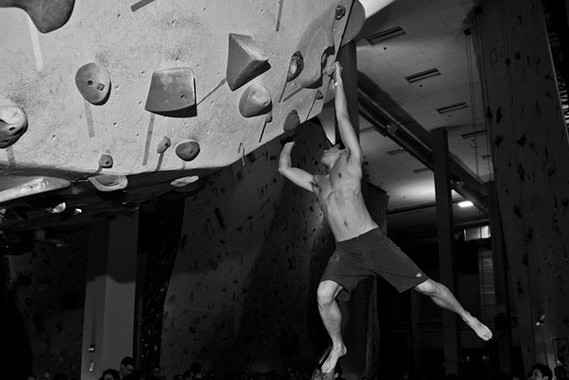This training guide, shared from our local gym, provides a regimen for how you can improve your climbing—both physically and mentally—through a simple 10-week training cycle. The training guidelines and tips have been adapted from Eric Horst’s Training for Climbing and How to Climb 5.12.
10-week mesocycle
Weeks 1-4
This training cycle begins with a focus on your endurance climbing. In this phase you want to pick problems that are well below your ability and climb as many of them as you can without breaks. Over the course of these 4 weeks, you should gradually increase the number of laps (ascent + down climb) you complete—but don’t allow yourself to get completely pumped in the process. Instead, work to find rests while doing laps to help you build the endurance you’ll need for when you go to tackle harder and longer climbs.
Related: How to Breathe Properly: Breathing Techniques for Rock Climbing
Weeks 5-7
After you’ve accumulated a base level of endurance in your climbing, your intention for the next 3 weeks should be placed on developing your anaerobic climbing level. In other words, you want to focus on building muscle. Warm up sufficiently with stretching and laps on easy problems, and then tackle climbs at or above your limit. You’re building strength in this step, which might either come easy or take a bit extra out of you. Either way, remember: this is a process.
Related: 3 Phases of an Effective Climbing Warm Up
Weeks 8-9
After you’ve worked to build a solid base level of muscle, you should shift your focus to anaerobic endurance climbing for the next 2 weeks. This phase is all about working hard problems with no breaks. Try to maintain a 3:1 ratio of climbing to rest. You should feel very tired and likely a little bit demoralized. Keep at it. If you can climb with both endurance and strength, just wait until you’re training’s over … sending will feel easy.
Related: Free eBook — 6 Training Games for All Levels of Climbers
Week 10
Rest. When you’re done, go climbing and surprise yourself. Then treat yourself to a dank burrito and a beer.

Other tips for 10-week climbing improvement
Improving your mental game
If you’re scared of heights, topping out, or just don’t feel comfortable doing something on a route, hang in there—literally. Stop where you are and regain control. Look at where you are and let your brain take over the emotional response you’re experiencing.
If you say,
I can’t do that,
or
I won’t be successful
– you’re right, you can’t or you won’t. Stop yourself. Negative self-talk can easily be the primary reason why you aren’t sending. If you don’t believe, you won’t send. So give it a try: just believe.
Related: Mastering the Mind: An Interview with Mental Training Specialist, Paul Roberts
Physical tips
If you feel like your legs are too weak
Skip down to “skill.” Legs are never the problem.
If you feel like you can’t hang on
Work on vertical pinch skills, work on crimps (open and closed), and really watch your hand work. Don’t cheat on easy holds, like open crimp jugs. Most importantly, don’t overdo it. If your hands are sore, take it easy; finger injuries are all too common. And, if you’re brand new to climbing, don’t be too hard on yourself if your hands shake and you can’t hold on. Stick with it; it gets easier.
If you get pumped easily
Give the cycle training above a try.
If you just feel weak
Work on developing your core and maintaining muscular balance. There are plenty of exercises out there that work your core because that’s a prime source of your power. At the same time, remember that injury comes out of imbalance. Don’t spend all your time doing abs and pull ups. Do push ups and back workouts to balance your shoulders; essentially make it a priority to work your opposing muscles.
Related: “Core Up!” What It Means and How to Do It
Skill
Most of the time, this is your problem. Climbing is not an inherent skill for most of us.
If you are a new climber
Everything feels weird. Take some time to research specific climbing moves and holds, or just watch the crushers at your gym. Try lots of different problems and if possible, get outside. Bouldering in the gym doesn’t exactly translate to climbing outdoors. Your goal at the beginning of your climbing isn’t to rack up high grades; it’s to climb a high volume of beginner problems to learn the terrain that’s out there.
Related: eBook — Rock Climbing Fundamentals: Essential Terms, Techniques, and Tips for the New Climbers
If you are an established climber
Continue to work on a high volume of climbs at the levels you’re comfortable with. You’re not a VX climber unless you can go anywhere and climb VX routes. No VX should shut you down. If it does? Work on skills you are missing —try doing laps, down climbing, climbing faster, improving your footwork and handwork. Do whatever you can to add tricks to your bag.
Now to you
Have you tried a similar training regimen? Think it works or that it’s complete bogus? Let us know your thoughts in the comments below.








